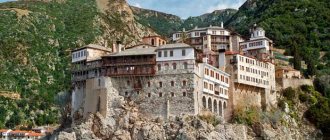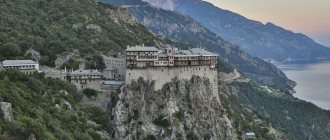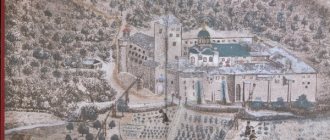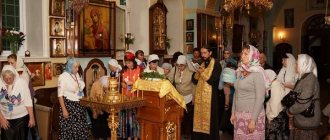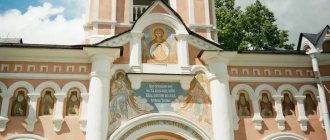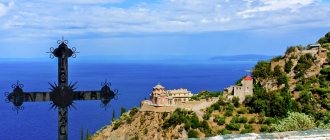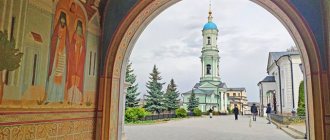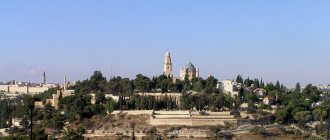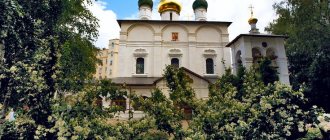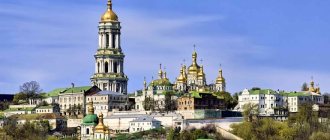Greece is a country that has preserved the cultural wealth of the ancient world. Every corner in these parts is connected with events of world history. A special aura of mystery surrounds the holy Mount Athos - a monastic abode for thousands of true Christian believers and a place of pilgrimage for millions of followers of the religion. The prayed-for, miraculous and incredibly beautiful land attracts tourists from all over the world.
History of Athos
The Thracians were the first to settle on the island of Athos in Greece. This happened 1000 years before the birth of Christ. Favorable natural conditions allowed them to lead a solitary lifestyle.
According to Thracian legend, the island received its name in honor of the mythical giant Athos. In a fight with Poseidon, the titan grabbed a rock and threw it at the enemy. However, Athos missed and the rock stuck into the ground. This is how the future “Holy Greek Mountain” appeared.
Five centuries later, the first Greeks settled on the peninsula, bringing with them the beginnings of Greek culture. In the 7th century AD (691-692), this land turned into an exclusively monastic monastery, and in 1144 it was officially given the title “Holy Mount Athos.”
These events were preceded by the appearance of a legend telling about the journey of the Virgin Mary and the Apostle John the Theologian, which took place in 49. Their ship washed up on the Greek island of Athos as a result of a powerful storm. Coming ashore, the Mother of God was so amazed by the beauty and atmosphere of the place that God gave this land under her protection. Since then, instead of the official name, the phrases “The Lot of the Virgin Mary” or “The Garden of the Virgin Mary” are often heard from the lips of monks and pilgrims.
History of the monastic state
The Holy Mountain became a haven for monks somewhere at the end of the 7th century. In 883, Emperor Basil the Macedonian approved in writing Athos as a place of residence only for monastics. During the Crusades, Athos came under the influence of Catholics, but the monks did not accept Uniateism.
At the beginning of the 14th century, the temples of the Holy Mountain were devastated by Catalan mercenaries, but by the end of the century there was an economic and spiritual recovery. At this time, the ideas of hesychasm - a special feat of solitude and prayer - turned out to be the most powerful.
In the 15th century, Thessaloniki was conquered by the Turks, but Athos continued to live for a long time, until the mid-16th century, without losing its rights. In 1566, Sultan Selim II took away all the lands from the Athos monasteries.
In the 7th-8th centuries, Athos became a place of enlightenment for the Greek people. At this time, the Afoniad was founded, and a printing house began operating in the Great Lavra.
In 1821, Mount Athos was occupied by the Turks, and the oppression of the Holy Mountain residents began. Thanks to the peace treaty between Turkey and Russia, liberation came in 1829 and lost property was returned.
In 1912, new unrest followed due to disagreements between Russian monasticism, which continued to submit to the Russian embassy in Constantinople, and Greek, who wanted Athos to join Greece. At this time, Russia proposed the creation of a self-governing autonomous monastic state, which was accomplished in 1924.
During World War II, the German occupation forces did not harm the property of the Holy Mountain, and did not deprive any of the monasteries of Athos of self-government.
At different times there were different numbers of inhabitants on the Holy Mountain. The smallest number of Svyatogorsk residents lived in 1971 - about a thousand people. Since that time, the number of inhabitants has been constantly growing. Now, at the beginning of the 21st century, about 1,800 monks are working on Mount Athos.
At the end of the 20th century, the Holy Mountain was included in the UNESCO World Heritage List, after which a large number of pilgrims and tourists flocked to Athos.
Geographical and political position of the island
Looking at the map, you will notice that the geographical contours of Athos also look special. It is an integral part of the Halkidiki peninsula, very similar in its outline to a hand with three fingers. The eastern “finger”, washed by the Aegean Sea and the Singitikos Gulf, is the Athos peninsula.
It is noteworthy that the Orthodox Mount Athos in Greece served as a reason for obtaining absolute sovereignty. Legally, this territory is independent from the Greek authorities and is in a self-governing position. Thus, Athos is a full-fledged monastic state, subordinate exclusively to church authorities, and specifically to the Patriarchate of Constantinople.
Administration of Mount Athos: who governs the monastic republic?
Mount Athos is governed by the "Holy Kinot" - a council of representatives of 20 monasteries with the participation of the Greek state through its representative in the capital of the monastic republic of Karyes. The executive body of the “Sacred Cinema” is the four-member “Holy Epistasia”. Responsibility for spiritual matters rests with the Ecumenical Patriarchate of Constantinople, while matters of public order and security belong to the representative body of the Greek state.
Climate and nature in the vicinity of Mount Athos
Like the entire Mediterranean, Athos has a comfortable subtropical climate. There are very long summers and not frosty winters. For pilgrims, the best season will be autumn: the summer heat will subside, and the cool, rainy season of winter will not yet begin.
The island is surrounded by dense forests. Many rare species of vegetation have been preserved here, untouched by the influence of animals. The monks provide for their own needs, so extensive orchards, olive plantations and vineyards will delight the eye. And drinking water is obtained from the purest high-mountain springs.
Monasteries of Athos
The entire territory of the peninsula is divided into areas belonging to monasteries. There are 20 monasteries on Mount Athos, and according to the adopted charter, the formation of new settlements is strictly prohibited.
The monastic republic is self-governing, and every year supreme representatives from 4 monasteries are elected (Holy Epistasy). Thus, 5 monastic groups were formed:
- Great Lavra, Esphigmen, Xenophon, Dochiar.
- Karakall, Vatopedi, Kutlumush, Stavronikita.
- Iversky, Simonopetra, Philotheus, Pantocrator.
- St. Paul, Hilandar, Grigoriat, Xiropotamus.
- Konstamonite, St. Panteleimon, Dionysiatus, Zograf.
The status of a monastery not only ensures participation in power, but also gives the right to own territory.
Among the Greek monasteries on Mount Athos, the oldest is the Great Lavra, founded by St. Athanasius in 963. On its territory there is a monastery with ancient frescoes and many Christian relics. Among them are the miraculous icons “Ekonomissa” and “Kukuzelissa”, the cross and staff of St. Athanasius, the relics of saints and parts of the tree of the Holy Cross.
Lavra of St. Athanasius (Great Lavra)
Caracal
Monastery of St. Paul.
Monastery of St. Panteleimon
In addition to the monasteries, there are 12 monasteries on Mount Athos. These monastic settlements do not have any rights and depend on the monastery to which the territory belongs. In total, 1,500 monks live on the island.
general information
Capital: Karye (Kareya).
Governance: The sovereignty of Athos is secured by the Treaty of Lausanne in 1923, and since 1926 the peninsula has been part of Greece. The Autonomous Monastic State of the Holy Mountain is a self-governing community consisting of 20 Orthodox monasteries and based on the provisions of the first Charter of the Holy Mountain ("Tragos").
Geography: The Holy Mountain Peninsula occupies the extreme eastern tip of the Halkidiki peninsula. The local terrain is a gradual transition in the southeast direction from the lowland to the rocky mountain range, which ends in a pyramid (height - 2033 m).
Area: 335.63 km2
Climate: Subtropical (Mediterranean). The peninsula has mild, rainy winters and fairly hot summers. Snow falls relatively rarely and melts quickly. The main source of drinking water is streams flowing from the mountains.
Population: 2262 people (2001)
Population density: 6.7 people/km2
Features: On Athos, the Julian calendar is used everywhere, including in administrative documents. The Holy Mountain is a UNESCO World Heritage Site. Women are prohibited from entering the territory of the “monastic republic”.
Athos is a peninsula crowned by the mountain peak of the same name. This is a place of constant prayer to God. On the territory of a unique monastic republic, the population of which is represented exclusively by men, there are 20 monasteries and 12 hermitages.
The Holy Mountain is the center of the Orthodox world, the focus of its priceless wealth. The monasteries contain manuscripts and icons, relics and relics of saints (including part of the relics of Ivan the Baptist and the remains of Mary Magdalene), and even part of the cross on which Jesus was crucified.
Gregoriate Monastery. Saint Athos
My country is Athos! My sweet peninsula! You are pierced into my chest with Your sharp peak!
Why did he cut me into two unequal parts? One is a bundle of love, the other is a bundle of pain! Hieromonk Simeon
Saints of Athos
The Holy Mountain of Greece has its own heroes. The list of revered saints who worthily passed through the hardships of earthly life contains many names. The monks carried their faith with ecstasy and were ready to accept any torment. A striking example of such an act is the story of St. Agapius.
He was a novice of the elder from the cell of the Holy Trinity. One day Agapius went down to the sea, but at that moment pirates landed on the shore. They captured the monk and took him to Magnisia, where they sold him into slavery to a Muslim. For 12 years Agapius lived in hard work and constant prayers for salvation.
The Mother of God heard his requests and appeared. She unfastened the chains, opened the doors and ordered the monk to flee to Athos. Agapius fulfilled the command and returned to the elder. However, he did not accept it. “You deceived your master, but you cannot deceive God. At the hour of judgment, you will have to answer for the pieces of silver that he spent on your purchase. Return to your master and serve him, and when the Lord bless him, he will let you go. This is how you will find your salvation,” these were the words of the wise old man.
Agapius obeyed the order. The Muslim was surprised at the return of the fugitive. The monk’s virtue and fierce faith impressed the owner, so much so that he took his sons and went with them and the former slave to the island of Athos. They accepted the Orthodox faith and lived in humility and virtue until the end of their days.
Venerable Agapius
Sights of Athos
The peninsula is home to a large number of interesting attractions, especially religious ones. There are many ancient and beautiful monasteries here.
Dochiar is a male Orthodox monastery located in the southwestern part of the island of Athos, off the coast of the Aegean Sea. The formation of the monastic monastery dates back to the 10th century, the founder was Euthymius of Athos. In the 16th century it was defeated by the Turks, but the monastery was restored again. In the hierarchy of Athos monasteries it is in 10th place. Dohiar is surrounded by groves and gardens; there are stunning and beautiful landscapes here.
The monastery houses the miraculous icon of the Mother of God “Quick to Hear.” She stands in the morning chapel. The icon was painted in the 10th century, during the period of the abbess of Neophytos. According to a legend from 1664, a monastery cellarer named Nil treated his face carelessly and, as a result, was struck by blindness. He repented and was healed. After this incident, many believers came here in need of physical and mental healing. In addition to the icon, the premises of the monastery contain relics and relics of saints, a piece of the Holy Cross of the Lord.
Dokhiar is the highest of all similar monasteries on Mount Athos; the cladding of the building is made of marble. Between the rooms from the temple to the refectory there are icons depicting the first three abbots. A well appeared on the territory of the monastery in 1299, which was called sacred. It appeared on its own and is a real miracle.
Not far from Dochiar in the west of the peninsula is the monastery of Xenophon. It was founded in the 10th century by a nobleman from Greece named Xenophon. 30 monks live and serve here.
There are many shrines in Dohiar
The monastery was ravaged by pirates in 1285, but two Vlachian boyars restored it in 1545. There is a Cathedral Church dedicated to St. George the Victorious, where significant mosaic icons painted in the 11th century are kept:
- icon of the Great Martyr George the Victorious;
- Icon of the Great Martyr Dmitry of Thessalonica.
Another valuable icon of the temple is the miraculous image of the Mother of God “Hodegetria”. For a very long time the icon was in the Vatopedi monastery, but suddenly, in 1730, it disappeared. At the same time, the doors of the temple were well locked, and no one entered inside. She was nowhere to be found on the territory of Vatopedi. Soon the monks from the brethren reported that they had seen the image in Xenophon, which took about 4 hours to walk on foot. The icon was moved back, but it miraculously ended up in Xenophon again. After this, the servants of the Vatopedi monastery no longer resisted the will of the Mother of God and did not transfer the face back.
There is also an unusual story associated with the icon of St. George the Victorious. She ended up in Xenophon inexplicably, although she had previously been in Constantinople. There is blood and a scar on the face - this is a mark from the blow of a Turkish fanatic.
The uniqueness of the monastery also lies in the presence of two Catholicons. This is not the case in other monasteries of the Athos Peninsula. The oldest building in the monastery is considered to be the chapel of Demetrius of Thessalonica. It is located on the right side of the altar of one of the Catholicons. On the territory of Xenophon there is a large library containing 4,000 printed books and 300 manuscripts.
Panteleimon Monastery stands on the coast of the Aegean Sea. Other names of the monastery:
- New Russian.
- Rossikon.
It is one of the ruling monasteries of Athos. According to tradition, Rossikon is considered a Russian monastery, but it became truly Russian only at the end of the 21st century. In the same century, the monastery came under the control of Russia and the Russian Orthodox Church. The first Russian leader to visit the monastery was Vladimir Putin. He arrived here in 2005.
Panteleimon Monastery is considered a Russian monastery
After experiencing decline in the 18th century, in the 20th century it became the largest monastery on Mount Athos, not only in area, but also in the number of monks in the brethren. In 1903 there were 1,446 monks. There have been many fires in the history of Rossicon, the most famous of which occurred in 1307 and 1968.
The monastery is remembered in history for a large number of feats performed by local Russian monks. The most famous of them was an old man named Silouan. The bells of the monastery in the 19th century were recognized as the largest in all of Greece.
The New Russian Library and several shrines are the real treasures of the monastery. The library stores 20,000 manuscripts and books. During a fire in 1959, it was badly damaged. Among the shrines are:
- relics of Saint Panteleimon;
- relics of John the Baptist;
- Icon of the Mother of God “Jerusalem”;
- ancient image of St. Panteleimon.
The monastery of Vatopedi is located in the north-eastern part of the Athos Peninsula. On one side of it is the monastery of Pantocrator, on the other - Esphigmen. The foundation of the monastery falls on the period 972–985. This is a Greek Orthodox male monastery. In the hierarchy, Athos is second. Vatopedi is one of the oldest, largest and richest monasteries on the island.
The monastery was built by three wealthy and noble people: Anthony, Athanasius and Nicholas. They all became monks and studied with the Monk Athanasius of Athos himself. He sent all three to live in the place where Vatopedi stands.
Vatopedi is one of the most ancient monasteries of Athos
The main cathedral of the monastery was built in the 10th century; in addition to it, there are 16 churches on the territory. The monastery houses many shrines, including miraculous icons of the Mother of God:
- Uncleaning.
- Slaughtered.
- Otrada.
- Ktitorskaya.
- Proclaimer.
- Pyrovlifissa.
One of the priceless local shrines is the Belt of the Blessed Virgin Mary. According to legend, this relic belonged to the Mother of God. The belt is kept in the chapel of the Holy Belt.
The “Slaughtered” icon has been kept in Vatopedi since the 14th century and is located in the chapel of St. Dmitry. The name was given to the image after a story that took place in the monastery church. The deacon was late for the meal and, after the refector refused and did not give him anything to eat, he went back to church in anger. There he stood in front of the icon and said that he was working, and he didn’t even have a piece of bread to bolster his strength. After that, he picked up a knife with which he scraped off the wax and hit the image in the face. Immediately blood flowed from the icon, and the deacon lost his sight. He fasted and repented for 3 years, asking the Mother of God for healing. The deacon was healed and later died. After burial, the right hand with which he committed the act did not decompose. It is kept in the monastery cathedral.
Holy Lavra - the main monastery of Athos
The icon “Pyrovlifissa” is located above the gate at the entrance to the monastery. Its name translates as “Shot through.” A soldier from Turkey in 1822 fired and hit the right hand of the Virgin Mary in the image. Immediately after his deed, he lost his mind and hanged himself on an olive tree.
The Vatopedi library contains one of the rarest and richest collections of books. In total there are more than 10,000 printed publications and 2,068 manuscripts. The historical value of the monastery library is the Geographical Guide with maps, which was written by Ptolemy.
The monastery has a brotherly tomb where the bones of 1,000 years of dead monks are kept. This is an Athonite custom, according to which a deceased monk is buried, after 3 years his remains are dug up and stored in a common tomb. The color of the bones speaks of the afterlife. If the bones are yellowish, it is believed that the deceased especially pleased the Lord. If the remains are not completely decomposed, they are buried again, and the brethren pray for the deceased.
The Great Lavra is the main monastic monastery throughout Mount Athos. It is located on a small plateau in the southeastern part of the peninsula. The sea coast is a 30-minute walk from the Great Lavra. Athanasius of Athos founded the monastery in 963. The Lavra has a Cathedral Church, where frescoes from the 16th century are kept. The frescoes were painted by the Orthodox icon painter Theophan of Crete. There are many shrines in the monastery, including:
- the rod and cross of St. Athanasius;
- miraculous icon “Kukuzelissa”;
- miraculous icon "Economissa";
- relics of St. Basil the Great;
- elements of the life-giving tree of the Cross of the Lord.
Holy Mount Athos and Russian pilgrims
The first records of Russian travel to Athos date back to the time of the Baptism of Rus, when the island was visited by St. Anthony of Pechersk. He lived here for a long time, and then went to Kyiv for missionary purposes, where he founded the first center of monasticism - the Pechersky Monastery.
Back in 1016, a Russian monastery was founded on the Athos lands, but exact data about it has not been preserved. In the 12th century, Russian monasticism received the Russik monastery on Athos, which developed throughout the Middle Ages. Although at times it was quite difficult for the monks, and the monastery fell into complete decay.
Today, the center of Russian Orthodoxy on Mount Athos is the monastery of St. Panteleimon. Sometimes it is called: “Rossikon” or “New Russik”. Also inhabited by Russians are the monastery of the Prophet Elijah and the monastery of St. Andrew.
Svyatogorsk Fathers
Over the thousand-year history of Athos, a great many saints have shone here - Gregory Palamas, Gabriel of Athos, John the Russian, Cosmas of Aetolia, Silouan of Athos, - the Council of the Reverend Fathers of Athos.
The Council of all the saints and saints who shone on Mount Athos
The Lord glorified the great ascetics of the 20th century - Elder Paisius the Holy Mountain and Joseph the Hesychast - great prayer books and mentors of the lost and perishing sheep, born in the sorrowful twentieth century. The Holy Fathers are glorified as saints. Paisius the Holy Mountain is commemorated on July 12, and Joseph the Hesychast on August 28.
All holy fathers of Mount Athos, pray to God for us!
Women on Mount Athos
Women and children under 12 years of age are strictly prohibited from visiting the Athos monastery. The taboo was violated as a last resort: when the lives of women and children were in danger, they could take refuge in the church. Today, women face up to a year in prison for entering Mount Athos.
Ladies can admire views of the island from a distance of 500 meters. Special sea cruises are organized for this purpose. From a comfortable boat slowly cruising along the coast, you can admire picturesque landscapes, ancient monasteries and the Sacred Mountain.
Pilgrim's Reminder
Pilgrims begin their journey from the city of Ouranoupolis, located at the foot of the Holy Mountain. From Ouranoupolis there is a daily ferry to Daphne, the main port of the Holy Mountain.
Port of Daphne
The infrastructure of the area began to develop at the end of the 20th century - dirt roads were laid, hotels and hostels were established. All this is done for the convenience of pilgrims, but the Holy Mountain residents themselves are not particularly happy with this state of affairs.
Article 186 of the Charter prohibits women from staying on Mount Athos. Violation is punishable by imprisonment for a term of 8 months to a year. In addition, it is prohibited to bring female animals to the Holy Mountain. The ban does not apply to wild animals, chickens that lay eggs needed in painting, or cats that destroy rodents.
The ban on women visiting Athos (Avaton) is very strict, because it was given by the Mother Superior of the Holy Mountain herself.
Before joining the European Union, one of the mandatory conditions put forward by Greece was the preservation of the Decree on prison sentences for women who violated the entry ban.
Men can obtain a special permit - diamonitirion - to stay on Mount Athos for up to 4 days. You can get it at the Thessaloniki Pilgrim Office. If necessary, diamonitirion can be extended in Karea. Priests must obtain a blessing in advance to visit Mount Athos from the Ecumenical Patriarchate. Christians of any denomination can visit Athos. Sectarians and pagans are prohibited from entering the Holy Mountain.
On Mount Athos you need to follow certain rules. You cannot wear shorts, short-sleeved shirts, swim in the sea or sunbathe. You cannot swear or use foul language, shoot videos or take photographs. You should not try to cheat and secretly smuggle a video or film camera - it will be taken away during customs inspection. You cannot bring dogs or hunting rifles to Mount Athos.
There is a bus from the port of Daphne to Kareia, but it is best to go on foot, then you will be able to see the beauty of Athos untouched by civilization, and perhaps meet ascetic devotees.
Visa to Mount Athos
Men can enter the Orthodox mountain in Greece after receiving a special permit called Diamonitirion.
You must apply for entry one month before your visit. To do this, you must inform the Pilgrimage Bureau of your arrival date and send a copy of the first page of your passport. The request is submitted free of charge, but the issued permit will need to be paid directly upon receipt in the city of Ouranoupolis (cost 25 euros).
The visa gives the right to stay on the peninsula for 4 days and spend the night in any of the monasteries. If desired, in Karei you can extend the validity of the permit. Accommodation in the monastery is free, but it is better to thank the monks for their hospitality by purchasing their souvenirs.
The application procedure can be simplified, because Many travel agencies offer diamonitirion registration. True, such a service costs more than 100 euros.
Visiting Athos – Athos Pilgrimage Bureau
To visit Mount Athos, you need to contact the pilgrimage office and plan the exact dates of the visit, which will be included in a special pass-visa for Athos - Diamonitirion.
- Address: st. Egnatia 109, Thessaloniki 546 35
- Phones: Thessaloniki - (+30) 2310 252–575, Ouranoupolis - (+30) 23770 714–21
- Fax: (+30) 2310 222–424
The data that must be provided is first name, patronymic, year of birth, ID or passport number, date of issue and the authority that issued the document.
A representative of the pilgrimage office in Thessaloniki will provide all the necessary information regarding entry to Mount Athos from Ouranoupolis or Ierissos.
Diamonitirion is issued by the bureau office in Ouranoupolis, on the day of entry to Mount Athos.
- Opening hours: Monday to Friday from 05:30 to 13:00, Saturday from 06:30 to 13:00 and Sunday from 08:00 to 13:00. Pilgrims must arrive at least 1 hour before ferry departure.
How to get there?
The sacred Mount Athos in Greece is located on a part of the peninsula closed to the laity, so the path to it is not easy.
First you need to arrive on the Halkidiki peninsula. You can fly into Thessaloniki airport or travel here from another city in Greece by bus, train or taxi. True, such a trip will not be complete without numerous transfers.
You can get from Halkidiki to Athos only through the seaport of Daphne. The path to this bay lies through the town of Ouranoupolis. Regular buses run from the bus station in Thessaloniki to Ouranoupolis. The price of a one-way ticket is 12.5 euros. The trip will take from 2.5 to 3 hours. By deciding to order a taxi, you will reduce the time spent by 2 times, but will pay 120-140 euros for the trip.
Detailed map of the Athos Peninsula
The first idea of what Athos looks like is given by a map of Greece and the Chalkidiki peninsula. Let's now look at a detailed diagram that shows all the roads and monasteries on the territory of Athos.
First of all, we arrive at the port of Daphne - the sea gate of Athos on the map of Greece. In the diagram they are indicated by a red dot. Notice another large red circle. This is Kareya - the administrative center of the monastic state. There are shops, a post office, cafes and other benefits of the new civilization. This is the only place that can be spoken of as a city where the holy Mount Athos is located. Everything else you will see are monasteries, monasteries and cells, where you can take a break from a long walk.
If you want to climb to the top of the mountain, then pay attention to the southern edge of the island. The place where the holy mountain is located is marked with a red triangle, and next to it we see an indicator of the height of Athos and the designation of the cell of Panagia.
Actually, the entire peninsula is a neighborhood of large monasteries and small hermitages. You can get to some of them directly from the ferry that docks at their piers. Others can only be reached on foot. But what is Mount Athos of Greece? This is a constant search for a way.
Athos in mythology: what was on Athos before the Orthodox monasteries?
At the western tip of the peninsula, on a plain called Phlegra (“fiery”), the legendary battle of the titans took place. The ancient Greek gods, led by Zeus, fought with the sons of Uranus and Gaia.
Chalkidiki is a sacred place - the battlefield of the gods. At the top of Mount Athos, a temple was once built with a statue of Zeus with two huge diamonds instead of eyes that glowed at night.
Zeus, Apollo, Dionysus, Hercules, Titan Creus, Aphrodite, Urania, Morpho, Artemis, Dimitra and other deities were revered here.
The Pantheon of ancient Greek pre-Christian Mount Athos was dominated by Artemis. Due to the wild nature and rich fauna, this particular goddess was best associated with the area. Apollo's sister reigned in wild virgin forests, not desecrated by human hands.
Mystical places on the Holy Mountain
Like any territory, the Orthodox Mount Athos in Greece has its secrets and mysteries.
Thus, in the highlands there is the Idolio rock. At the dawn of the settlement of the island, there was a large pagan temple here. Passage to this peak is strictly prohibited, although a well-trodden path leads to it. Numerous crosses are installed along it, protecting the Orthodox land from the penetration of evil spirits.
Locals also try to avoid the Mogul monastery, which was once located just above the Great Lavra. Today there is a rocky slab, sloping into the sea.
According to legend, previously there was a skete under it, consecrated in honor of Basil the Great. Strong discord began among his monks, and suddenly they heard a strong roar of rockfall. At that moment, a huge rock, towering 500 meters above their monastery, crashed down with a roar and swept away all traces of the monastery mired in strife. All that remained was a deserted slab, where the roar of rockfalls can still be heard.
Beaches and resorts in Athos
If you are planning a beach holiday, it will only be available in Ouranoupolis or Nea Roda. In the Orthodox part of the island it is strictly prohibited:
- wear bright clothes;
- bare legs and shoulders;
- swim and have a sunbath;
- to swear;
- conduct video shooting.
In addition, the daily routine established by the monks should be followed.
At the resorts you will find both comfortable beaches and attractive wild areas, to which a taxi will take you.
Pilgrimage
For those who suffer to set foot on the land of the Holy Mountain and touch the origins of the true faith, there are strict rules, the observance of which is strictly observed by all pilgrims. Only men of any religious belief can come to Athos, who must first obtain permission (diamonitirion) . Orthodox clergy also need additional permission issued by the Ecumenical Patriarchate. Women are not allowed into the territory of the “earthly inheritance of the Virgin Mary,” even despite calls from the European Union to establish gender equality.
But there is a monastery in Greece where nuns live in strict accordance with Athonite rules. First of all, women come here for whom the holy land of Athos is inaccessible. The women's monastery is located in the village of Suroti, and it was founded by the Athonite elder - Saint Paisius the Svyatogorets, who until his death looked after and helped the nuns with wise advice. He was buried outside its walls and many pilgrims seek to venerate the holy relics, which have miraculous powers.
While on the Holy Mountain, pilgrims must wear clothes of soft colors that cover their legs and shoulders. It is forbidden to swim, sunbathe, talk loudly and use foul language. While living in the monasteries, each pilgrim must adhere to the daily routine common to all monks of the peninsula.
Iviron
To take photographs in monasteries, you need to ask for permission; usually, the monks do not create obstacles, but photographing the inhabitants of Athos is highly not recommended. Video filming is strictly prohibited, therefore, when going on a pilgrimage to the Holy Mountain, you should not take a video camera with you.
The Holy Mountain hides within itself a special secret of life and an extraordinary power for rebirth. And many pilgrims, after visiting these places, find spiritual peace and inner fullness.
Hotels
On the territory of the sacred mountain, besides monasteries, you will not find any other housing. But in the resort part, in Ouranoupolis or Nea Dora, you can easily find an inexpensive and comfortable hotel on Mount Athos. The list of the best usually includes:
- Eagles Palace;
- Xenia Ouranopolis;
- Alexandros Palace Hotel;
- Hotel AKTI Ouranopoli Beach Resort.
A trip to Athos will delight you not only with the amazing beauty of nature, but also with the peaceful atmosphere of the Orthodox land, which leaves its own unique and indescribable impressions in everyone’s soul.
Hiking routes of Athos
Hiking on Mount Athos is common, but it is best to prepare for it in advance. Lush vegetation, virgin forests, beautiful paths, streams, small waterfalls, springs and many wonderful beauties of Athos await pilgrims on their way.
It is worth considering that in all the beauty of this pristine land there are pitfalls. To protect yourself, you need to remember that pilgrims, travelers and just tourists should know that the paths of Athos are marked for each direction in monasteries, cells, hermitages and arsanas (ports).
You should never deviate from your course, as small crossings and overgrown paths can lead to many dangers. Lush vegetation that covers the road or paths often leads to crevices, gullies and rocks that are adjacent to the roads and paths. Inattention can result in injury.
Due to numerous natural disasters, the ground is loose in many places. Walk on solid ground as much as possible and avoid going near the side of the road or trails where you are unsure of the stability of the ground.
